Frequent highlighting for more than 10 years has not lost its position; it is considered to be very popular and popular. And judging by these trends, it will be in trend for more than a decade. This dyeing technique will give catchy freshness and incredible shine even to plain-looking curls, visually add volume and special charm to any haircut. Highlighting with small locks, “feathers” or frequent - all this is one and the same method.
Features
At first, only blondes chose frequent highlighting, but nowadays, even the darkest hair can be decorated in a similar way. There are several varieties of technology at once, where small strands are taken for coloring.
- Californian. Here, several shades are used at once, which form a beautiful transition and give the effect of flowing hair, which is clarified by sunlight. Most often found in blondes and ladies with light brown hair.
- Venetian. A subspecies of the Hollywood type of highlighting, but is intended for darker curls.
- American In this case, tonal accents are placed in certain areas of a particular haircut.
- Veiling. Here only the upper part of the hair is dyed. The strands are selected as thin as possible (3-4 mm), almost translucent and therefore invisible to the inexperienced eye.




Frequent highlighting is perfect for mistresses of thin hair, which are devoid of volume. It will visually allow the hairstyle to look thicker, make the strands play with new and attractive shades.With frequent highlighting, your haircut will look simply stunning, but only if you initially entrust your hairstyle to an experienced master.

Comparison with rare
The painting technique, in which only a few strands is tinted, is called rare highlighting. The result is a very wide spread of thin, colored strands all over the head. With this type of staining, a certain sharpness of borders and catchy tone contrast will be characteristic. This type of highlighting is rarely tinted, keeping long distances between the selected locks.
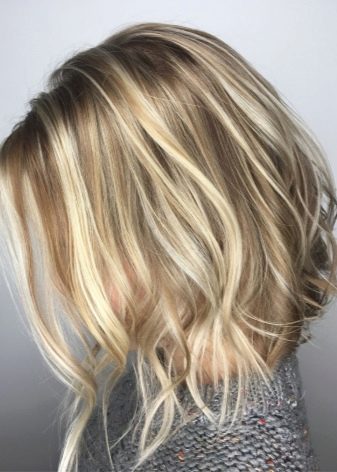

A rare highlighting looks quite catchy. Any initial hair color is suitable for him. The most important thing here is to correctly place the accents with the help of muffling or, conversely, highlighting the selected shade. This type of coloring can be considered almost harmless, since only a small part of the hair will be treated with paint. This means that the adverse effects of chemicals will be minimized. The technique of highlighting rare strands only outwardly seems simple, so it is best to implement it in a good salon. It is almost impossible to create perfect symmetry with your own hands.



A rare large highlighting is a real decoration for very thick hair, which will emphasize their luxurious color, give them a special depth and richness. But you can’t increase the volume by this method, because experienced craftsmen do not recommend choosing it on thin strands. A rare highlighting is best chosen for those women who do not want to spoil dye more than 50% of their hair and do not seek a cardinal change in appearance.

Advantages and disadvantages
Frequent highlighting looks great on strands of absolutely any length and absolutely any color. The game of colors will allow the locks to glamorously charm and gracefully shimmer in the light. Similar coloring will also allow:
- visually give the curls tremendous density and splendor (the volume is especially good on thin and rare curls);
- regain its natural color without damaging the hair at the same time;
- qualitatively “hide” gray hair.


Like other coloring methods, frequent highlighting has its drawbacks.
- It will cost a lot. The cost will be affected by the length of the strands and the number of shades selected. The longer the professional will work diligently on you, the greater the amount you will need to pay for his diligence.
- The duration of the procedure. If the locks are highlighted in one color, then expect to stay in the master’s chair for at least 1 hour. Want to get transitions from 2-3 shades, then you have to linger in a chair for 3-6 hours.
- Dry hair. Although many masters call highlighting a gentle procedure (it will affect at least 40% of the hair), however, it can still significantly worsen the condition of the processed curls. But if, after highlighting, you begin to competently take care of your hair, this minus can be safely deleted.

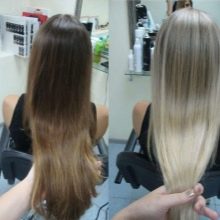

Who is going to?
Staining with frequent locks can be considered one of the most universal ways of transforming hair. It will perfectly highlight the brightness of the blonde, and the red-haired lady, and the brunette. The most important thing here is the right choice of a palette of shades that should ideally combine with the natural coloring of the hair, as well as the color of the skin and even the eyes.



Frequent highlighting will look beautiful both on long curls and on those who prefer a shortened haircut. To hide the gray hair, you can use a very fashionable technique called "salt and pepper." Here, the gradient from white and light gray to black is almost invisible to the eye due to a set of very thin locks.


For blond and light brown strands
Such light curls are the best option for a stylish gradient that will shine and shimmer in the rays of the bright sun. For coloring thin strands, a light walnut and natural beige tone are perfect.Girls with a cold color type should opt for ash or platinum colors, expressive pearl or mysterious mother-of-pearl color. Golden and honey, and with them wheat, is the best choice for women with a warm spring character.
You can select 1 or several tones at once, most importantly - one color spectrum. On dark blond strands, it is easier to choose the right shade, since almost all light colors will fit them. The “blonde” shades of milk color, bright pearl tone, honey shade, all light brown colors will be combined in the best way. You can safely experiment and perform frequent highlighting in combination with various shades of blond.



It is important to remember that the ash tone and its fellow, silver tone are extremely “capricious”, and are best suited only to girls with blue eyes and completely snow-white skin.


For dark curls
Highlighting on natural brown-haired and burning brunettes is quite difficult to implement and give them the effect of a natural or glare overflow. The selected tone will still be contrasted with the natural color of the hair. An exception can be called dark blond, for him a silver or gray, almost "mouse" shade is selected.


Among girls with dark curls, you can often find a warm (so-called autumn) type or a cold (called winter) color type. It is worth starting from them, choosing the most suitable color scheme for the technique of frequent highlighting.


The most suitable for women with a brown tint of curls will be considered such colors as honey and amber, as well as cognac and caramel. For burning brunettes, all coffee shades, the color of chocolate, bronze, copper, chestnut color are suitable. A silver tone or light gray look spectacular on black strands, but only if they combine beautifully with blue or green eyes.


On red curls, the coloring of small locks in golden, wheat, as well as amber and cognac colors will look stylish.
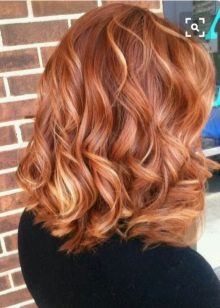


Execution technique
Frequent highlighting can be done in more than one way:
- purchase a special plastic hat;
- you can choose foil;
- use a rare comb.

Do not forget that the transformation process will be long and rather laborious. You do not need to perform this procedure at home if you do not have experience in this type of painting technique or there is no one to call for help. You can learn a little by looking at a special course on the video to understand exactly what kind of manipulations you will need during the highlighting.

3 days before the procedure, you should not wash your hair so that the skin under them is covered with a small greasy layer - it will protect your long or short curls from the harmful effects of chemicals.
For shorter haircuts, it is more convenient to use a special hat or a small comb with very rare teeth, for medium strands and long ones it is better to prepare a foil.

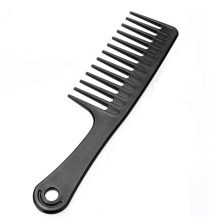

The cap for highlighting can be disposable (after the procedure is thrown away) and reusable (used more than a hundred times). A reusable product will be more dense. To color the strands, you will need to carry out their actions in the following order.
- It is necessary to comb dry curls as carefully as possible. The cap is put on the head and fixed with ties.
- Using a special hook or a regular knitting device, pull the same thin strands through the holes in the cap.
- Use a protective cape, put gloves on your hands. Prepare the dye.
- Using a brush or a special applicator, evenly distribute the composition over the strands that you pulled out from under the cap. It is best to start with the crown of the head, moving a little to the back of the head. Comb well each strand being processed.
- A plastic bag should be put on top of the dyed curls.Wait for as many minutes as indicated in the instructions for the paint.
- Rinse off the dye. Be sure to apply a protective balm on the colored strands.
- Further it is already possible to remove an unnecessary hat.
- Once again, you should thoroughly wash your hair and rinse your hair.
- If necessary, tint your locks.
- To prevent the paint from flowing under the hat, make it as thick as possible.


To make frequent highlighting using a comb, prepare a small comb or comb with rare and large teeth. Paint is applied to these teeth and all hair is gently combed with a comb. Remember to add coloring agent to the comb as necessary. After a certain amount of time, wash off the paint and apply a special mask or caring balm on the hair.

If you have long dreamed of making highlighting frequent strands on the foil, you should do so.
- First prepare everything - choose the right paint and the right tools for yourself. Cut wide strips of food foil if you do not have professional material. The foil strips should be wider than the strands, and approximately twice as long in length (if you plan to fold the strips in half).
- Comb your curls, dividing them into about 8-10 zones. They are fixed with hairpins or hairdresser clips.
- Prepare the paint.
- Throw something to protect your clothes, and don't forget gloves to protect your hands.
- Dissolve the curls on the back of the head, choosing from them locks of the desired width.
- Choose thin parts from the first wide lock for coloring. For your convenience, immediately place the colored strand on a strip of foil.
- Apply dye to the strands using a brush or regular sponge, high-quality coloring the curl from the bottom up.
- Wrap a strip on the sides and bottom, creating a semblance of an envelope, or lay another strip on top.
- Securely lock everything with a hairpin.
- In the same way, you should do with other outlined locks in the occipital region, then at the temples and on the top of the head, do the same with the bangs.
- Keep the dye on curls exactly as much as recommended on its box, and then rinse the paint well. Expand all strips with foil and carefully rinse the locks from each strip so as not to transfer the paint to pristine curls.
- Rinse the colored strands again, apply a balm on them.


Important tips for those girls who want to highlight their hair with frequent locks on this difficult technique:
- the foil is easily replaced with a conventional film - in this case, you can follow the process of lightening your strands;
- to fix with hairpins you need both tinted curls and those locks that you skip so that the result comes out more accurate;
- If you are not sure about the quick execution of your work, first select all the locks, securing them with clamps on the foil strips, and then start painting.
Before starting work, test the chemical product so that you do not end up with an allergic reaction.

Frequent highlighting is an extremely difficult and lengthy procedure. Applying it, you should remember about accuracy and patience, because an amazing result will be worth it.
Beautiful examples
Experts advise making tinted colored strands after fine highlighting. This will help even out the resulting color and give the haircut a stunning and well-groomed look.
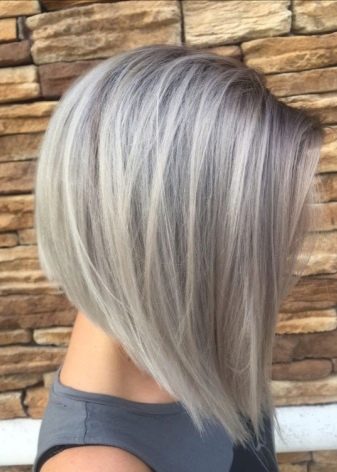
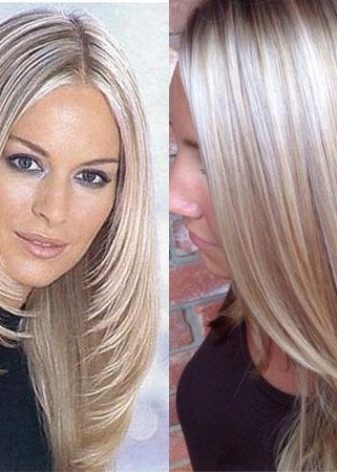
Modern masters master various techniques of frequent highlighting. One of the most popular types of this technique among professionals is Californian, or, as it is also called, Hollywood. He is very elegant and cast, does not harm the strands when stained.


The venetian technique of any beginner will impress with the illusion of natural hair burning.
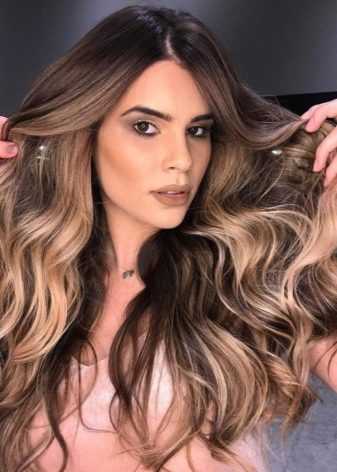

Classic frequent highlighting will illusory create an emphasis on the upper locks, giving smooth shiny overflows of colors.


About the features of highlighting correction, see the video below.










